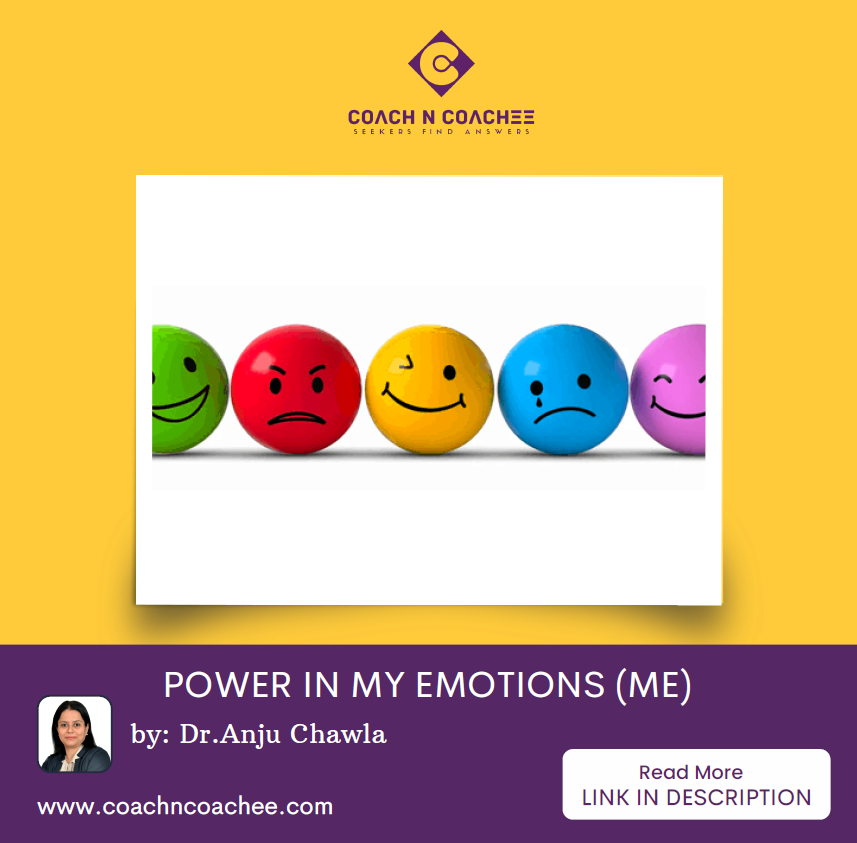
Power in my Emotions (ME)
I am a bundle of emotions and so are you, isn’t it?
Emotions are unpleasant or pleasant and emotional state can be positive or negative.
Emotions are such a natural part of our existence. Imagine, we can climb mountains, spend time with family and friends, do a thousand things, but without emotion what’s the point? Emotions give meaning, colour and texture to our lives – taking us from elation to sorrow, excitement to resentment, satisfaction to need.
While two persons are behaviourally transacting with each other to achieve a goal, let us assume Negotiation, they tend to experience some emotions in the process. It will end up being a meaningful conversation if and only if both or at least one of them has control on emotions and knowledge of managing other’s emotions. Emotional intelligence is that ability you have that allows you to be smart about your feelings and emotions. Those who are emotionally intelligent are also smart when it comes to sensing the feelings and emotions of others.
This skill of knowing one’s emotions, managing them and knowing other’s emotions and managing them for a goal directed behaviours is called #Emotional Intelligence.
World of Emotions is very powerful because emotions can either run your life or ruin your life. If one practices the skill of #Emotional Intelligence consciously then crisis and challenge can turn into opportunity. The skill may have been packaged and marketed a few decades ago, but in reality, it stems from ever since human are exhibiting behaviours with each other. From Salovey and Mayer’s contribution to the work of Dr. David Walton and John Gottman, the field of emotional intelligence continues to both motivate and inspire us to learn more.
The History & Evolution of Emotional Intelligence
In 1985, a man by the name of Wayne Leon Payne, a graduate student wrote a doctoral dissertation that happened to include the term “emotional intelligence.”
In 1990, John Mayer and Peter Salovey, two American university professors, were doing research in order to develop ways to scientifically measure the difference between people’s abilities in and around their emotions.
Mayer and Salovey soon discovered that some people seemed to be better than others when it came to identifying others’ feelings and solving problems involving emotional issues. One of these research papers was titled “Emotional Intelligence “.
Salovey and Mayer coined the term “emotional intelligence” in 1990, describing it as a:
“Form of social intelligence that involves the ability to monitor one’s own and others’ feelings and emotions, to discriminate among them, and to use this information to guide one’s thinking and action.”
Mayer and Salovey proposed the original framework of emotional intelligence, according to Raz & Zysberg (2014). It was defined as:
- Identifying emotions in the self and others.
- Integrating emotions into thought processes.
- Effectively processing complex emotions.
- Regulating one’s own emotions and the emotions of others.
Many studies have since shown that EI may, in fact, predict and account for a broad range of human behaviours, among them mental and physical health, life-satisfaction (self-reported) and well-being, positive social interactions, academic achievements, and work performance (Raz & Zysberg, 2014).
In 1992, while doing research for a book on emotions and emotional literacy, he discovered an article by Salovey and Mayer. According to the Yale Centre of Emotional Intelligence John Mayer and Peter Salovey are generally considered the founders of emotional intelligence. In 1987, the term emotional intelligence didn’t even exist yet.
The brilliant idea came about one summer when Salovey was painting his home along with his friend John Mayer. Salovey studied emotions and behaviour, while Mayer studied the link between emotions and thought. While they were painting and working they collaborated and discussed different theories of intelligence. The two also discussed the concern that certain theories of intelligence had no clear way of placing emotions. As they worked, they talked about the idea of a new kind of intelligence, the ability to understand recognize, utilize, and regulate emotions effectively in day-to-day life.
In a paper that was published in 1990, Salovey and Mayer described a revolutionary new idea – that of “emotional intelligence.” This may very well be the start of the emotional intelligence trend. The idea began to catch on and Salovey proceeded to become one of the field’s prestigious leaders, moving the idea of emotional intelligence forward. The Yale Centre for Emotional Intelligence continues to explore what EI really means.
Daniel Goleman is probably one of the most widely recognized. Goleman, a New York writer, and consultant began writing articles for Popular Psychology in the early 90s and then later wrote for the New York Times. While Salovey and Mayer may have coined the term EI, Goleman popularized it through his work and books.
Goleman expanded on Mayer and Salovey’s ideals, utilizing five essential elements of emotional intelligence:
- Emotional self-awareness or being aware of what you are feeling moment to moment as well as seeking to understand the impact this has on others.
- Self-regulation or attempting to control or redirect your emotions and learning to anticipate the consequences before you act on impulse.
- Motivation or utilizing emotional factors to overcome and persevere.
- Empathy or learning how to tune in and sense the emotions of others.
- Social skills or learning how to effectively manage relationships and inspire others.
According to Dr. Travis Bradberry and Jean Greaves, the program can help people identify their level of emotional intelligence while helping to build their EQ skills.
The book’s findings shed some much-needed light on difficult issues such as:
- Gender differences in terms of emotional intelligence.
- Generational differences in emotional intelligence.
- Cultural changes in terms of emotional intelligence.
- Societal shifts in overall emotional intelligence.
Research work doesn’t stop, the discipline only evolves.
Three Models of Emotional Intelligence
Emotional intelligence (EI) is a set of cognitive and non-cognitive competencies, skills, and abilities, directly and essentially connected to the behaviours and actions of everyone, in every field, including the actions of public administrators, policymakers, managers, and leader at any level of the organization bureaucracy.
The three major models of EI—Goleman’s EI performance model, Bar-On’s EI competencies model, and Mayer, Salovey, and Caruso’s EI ability model— resulted from decades of research, analysis, and scientific investigations. Those EI models focused on the individual’s cognitive and noncognitive competencies, skills, and abilities, with the purpose of understanding what emotions drive human behaviour.
According to Daniel Goleman, EI is an array of skills and competencies that contribute to the performance of managers and leaders in the workplace. Those skills and competencies focus on four capabilities: self-awareness, relationship management, self-management, and social awareness.
These four EI competencies are the foundation of twelves EI subscales that include emotional self-awareness, emotional self-control, adaptability, achievement orientation, positive outlook, influence, coaching and mentoring, empathy, conflict management, teamwork, organizational awareness, and inspirational leadership.
According to Bar-On, EI is an arrangement of interconnected behaviours driven by emotional and social competencies that influence performance and behaviours. Bar-On’s EI model focuses on five EI scales: self-perception, self-expression, interpersonal, decision-making, and stress management, and 15 subscales: self-regard, self-actualization, emotional self-awareness, emotional expression, assertiveness, independence, interpersonal relationship, empathy, social responsibility, problem-solving, reality testing, impulse control, flexibility, stress tolerance, and optimism, driving human behaviours and relationships.
Mayer & Salovey’s model of emotional intelligence (Mayer & Salovey, 1997) introduced the concept of emotional intelligence as a cognitive ability, which is separate from that of general intelligence.
The proposed model introduced four abilities or branches composed of:
- Perception of emotion.
- Emotional facilitation.
- Understanding of emotions.
- Management of emotions.
These concepts are ordered from the basic to the higher order abilities, which are thought to develop as one matures. The perception of emotion includes non-verbal signals and stimuli such as art and landscapes.
John Gottman and Emotional Intelligence
Gottman is world-renowned for his research on marital stability. He is the author of over 200 published academic articles and author and co-author of over 40 books including Raising an Emotionally Intelligent Child.
Gottman’s work involves children and strengthening emotional intelligence.
According to Gottman’s research, children begin consistently using more complex strategies for emotional self-regulation around the age of 10. These strategies are often broken down into two categories:
Those that attempt to solve the problem.
Those that attempt to tolerate the emotion.
In Gottman’s research, he discovered that when children attempt to make a change to address a problem or issue they engage in problem-solving. As part of this, they work to identify the trouble and then proceed to make plans for dealing with it.
On the other hand, if they deem an issue or problem unsolvable, they engage in emotion-focused coping and work to tolerate or control the distress they may feel. Gottman feels that academic achievement in childhood has been the primary focus over the years while emotional self-regulation has been for the most part ignored or underrepresented.
Given the fact that emotional intelligence is twice as strong a predictor of later success in life when compared to IQ, this is a poor strategy, according to Gottman. In one study, done in New Zealand, with more than 1,000 children involving cognitive control during school-age years, it was discovered that mental ability or EQ predicted financial success even better than IQ or the wealth of the family one grew up in.
Gottman’s research also reviews a five-step system of emotion coaching, as seen in the diagram below.
The Five Steps of Emotion Coaching
- Becoming more aware of your child’s emotions.
- Recognizing your child’s emotion as an opportunity for teaching or connection.
- Helping your child label their emotions verbally.
- Communicating empathy and understanding.
- Setting limits and problem-solving.
Emotional facilitation has to do with the ability of emotions:
- To help us think in terms of signaling environmental changes.
- Help us change moods to see situations in different ways.
- Assist us in different types of reasoning.
Understanding emotions involve concepts such as knowledge of emotions, emotional vocabulary, as well as changing emotions and creating other emotions over time.
Managing emotions has to do with the ability to not only manage your own own emotions in a healthy way but to also manage the emotions of others.
The journal article “Emotional Intelligence” (Salovey & Mayer, 1990) presented a framework for emotional intelligence describing it as set of soft skills, thought to contribute to the accurate appraisal of the expression of emotion in the self as well as others.
It also presented EQ as the use of feelings that can help us motivate, plan and achieve things in life. According to the research, one tradition in Western thought views emotions as a mere disorganized interruption of one’s mental activity.
A Look at Howard Gardner
Howard Gardner is a professor of cognition and education at the Harvard Graduate School of Education. Gardner has authored over 30 books and is best known for his theory of multiple intelligences. The book, Multiple Intelligences: New Horizons in Theory and Practice, distills nearly 3 decades of research on multiple intelligences theory and practice.
Gardner introduces the concepts of:
- Global applications,
- Multiple intelligences in the workplace,
- And an assessment of multiple intelligence practices in the current educational climate.
Gardner also reviews new evidence about brain functioning and nurturing intelligence in early childhood. Gardner introduced the theory of multiple intelligences in the early 1980s. He believes that human cognitive competence is best described in terms of a set of abilities, as well as mental skills or talents, which he calls intelligence.
He believes that all individuals possess each of these skills in some way, shape or form.
Gardner’s Work On Multiple Intelligences
In his theory, people simply differ in the degree and the nature of these combinations. Multiple intelligences are framed in light of the biological origins of each problem-solving skill. One example is language.
Language may manifest in different ways from writing in one culture to oratory in another to a secret language composed of anagrams or tongue twisters in another. According to Gardner, we are all so different because we have different combinations of intelligences. Gardner truly believes that if we could mobilize our full range of human intelligence and then ally them to an ethical sense that we could then increase the likelihood of our planetary survival as well as our ability to thrive.
Multiple Intelligences include the following:
· Linguistic intelligence (“word smart”)
· Logical-mathematical intelligence (“number/reasoning smart”)
· Spatial intelligence (“picture smart”)
· Bodily-Kinesthetic intelligence (“body smart”)
· Musical intelligence (“music smart”)
· Interpersonal intelligence (“people smart”)
· Intrapersonal intelligence (“self smart”)
· Naturalist intelligence (“nature smart”)
Phineas Gage: The Definitive Emotional Intelligence Case Study
In 1848 a man by the name of Phineas Gage sustained a terrible injury to his head. At the time, Gage, a 25-year-old man, was working as a foreman in support of the construction of the Rutland and Burlington Railroad in Vermont, USA.
Gage was injured during the construction, while the team was using explosive charges to blast away rock to clear a path for the railroad. As the story goes, Gage was using something called a tamping iron, a long hollow cylinder of iron that weighed about 6 kilos.
A Fateful Accident
On that fateful day, September 13, Gage’s iron rod hit the rock; accidently creating a spark that ignited the explosives. What happened next was unbelievable.
The rod was then propelled through Gage’s skull, entering through the left cheekbone and exiting through his skull, and the top of his head. The rod was then found approximately 30 yards away, smeared with brain and blood. However, despite this horrendous injury, Gage preceded to sit up and recount consciously what had just occurred.
Dr. John Harlow then dressed and cleaned the injury while examining Gage. Despite the doctor’s efforts to clean the wound and make sure that no brain fragments were left behind, the wound became infected and Gage fell into a semi-comatose like state.
While everyone prepared for Gage to die, Gage actually recovered later on that year. Henry J. Bigelow, a professor of surgery at Harvard University eventually reported that Gage was quite recovered in faculties of mind and body.
A Changed Man
Despite his recovery, Gage began to change. Gage’s personality and character began to shift dramatically. Gage became fitful, irreverent, even indulging at times in gross profanity. Gage changed so much so that his friends said he was no longer Gage.
So what happened, you might ask?
While the details may be unclear, it does seem like Gage suffered brain damage, most likely to the frontal cortex caused by the iron rod. This, in turn, resulted in the loss of social inhibitions.
At the time of his accident, little was really known about exactly how the frontal cortex worked in things like making decisions and social cognition. Neurologists were only just beginning to make these connections. Gage’s injuries were most-likely one of the first recorded evidence that the frontal cortex was involved in personality and behavior.
David Ferrier, a Scottish neurologist at the time who did research in cerebral function determined that damage to the frontal cortices had little to no effect in terms of physical abilities, in his research with primates.
However, his research did show a very decided alteration in the animal’s character and behavior. He then used the experience of Phineas Gage as a case study to fully support his claims. The details of Gage’s life after his accident are not fully known.
It is known that he worked as a coach driver for several years in New Hampshire before moving to Chile. After that point in time, Gage’s health declined and he returned to the U.S. Gage died in San Francisco in 1860 after suffering seizures that were most likely the result of his injury. We still have much to learn about the brain. Gage’s story is a fascinating one that is a good reminder that there is still a lot to learn when it comes to the miraculous brain.
The following section of the article is based on the information freely available at www.ei.yale.edu
The Yale Center for Emotional Intelligence was founded by Peter Salovey, and is currently being directed by Marc Brackett. The Center “uses the power of emotions to create a more effective and compassionate society”.
A key aspect of the center is the application of scientific research to develop effective approaches for teaching EI.. It also seeks to provide education on how to develop EI across the lifespan.
In a range of schools, the Yale Center uses a research-based, field-tested approach called RULER.
RULER was inspired by Marvin Maurer, a teacher who, in the early 1970s began using an emotional literacy program. RULER has been associated with improvements in students’ academic performance and social skills.
It has also been shown to help develop classrooms that are more supportive and student-centered. It includes tools, such as the ‘mood meter’: a RULER tool that helps students recognize and communicate their feelings.
Classrooms using RULER report less aggression among students than those classrooms not using RULER.
To learn more about RULER, a research article has been listed as one of the recommended papers in the earlier section of this article.
The Yale Center for EI’s mission is to utilize research to enhance real-world practice. The success of RULER has led Yale to produce similar programs to be delivered in ‘communities’ such as businesses, governments, and families.
The overarching aim is to harness the power of EI to help individuals achieve happier, healthier, and more productive lives.
AND SCOPE OF EMOTIONAL INTELLIGENCE IS STILL EVOLVING.









